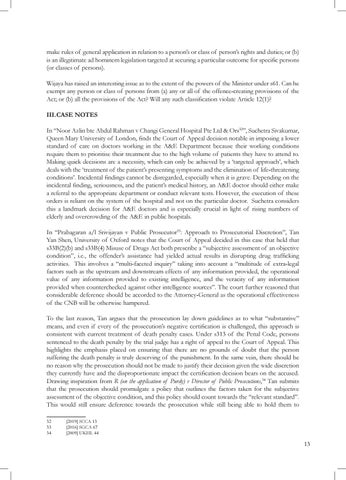make rules of general application in relation to a person’s or class of person’s rights and duties; or (b) is an illegitimate ad hominem legislation targeted at securing a particular outcome for specific persons (or classes of persons). Wijaya has raised an interesting issue as to the extent of the powers of the Minister under s61. Can he exempt any person or class of persons from (a) any or all of the offence-creating provisions of the Act; or (b) all the provisions of the Act? Will any such classification violate Article 12(1)? III. CASE NOTES In “Noor Azlin bte Abdul Rahman v Changi General Hospital Pte Ltd & Ors32”, Suchetra Sivakumar, Queen Mary University of London, finds the Court of Appeal decision notable in imposing a lower standard of care on doctors working in the A&E Department because their working conditions require them to prioritise their treatment due to the high volume of patients they have to attend to. Making quick decisions are a necessity, which can only be achieved by a ‘targeted approach’, which deals with the ‘treatment of the patient’s presenting symptoms and the elimination of life-threatening conditions’. Incidental findings cannot be disregarded, especially when it is grave. Depending on the incidental finding, seriousness, and the patient’s medical history, an A&E doctor should either make a referral to the appropriate department or conduct relevant tests. However, the execution of these orders is reliant on the system of the hospital and not on the particular doctor. Suchetra considers this a landmark decision for A&E doctors and is especially crucial in light of rising numbers of elderly and overcrowding of the A&E in public hospitals. In “Prabagaran a/l Srivijayan v Public Prosecutor33: Approach to Prosecutorial Discretion”, Tan Yan Shen, University of Oxford notes that the Court of Appeal decided in this case that held that s33B(2)(b) and s33B(4) Misuse of Drugs Act both prescribe a “subjective assessment of an objective condition”, i.e., the offender’s assistance had yielded actual results in disrupting drug trafficking activities. This involves a “multi-faceted inquiry” taking into account a “multitude of extra-legal factors such as the upstream and downstream effects of any information provided, the operational value of any information provided to existing intelligence, and the veracity of any information provided when counterchecked against other intelligence sources”. The court further reasoned that considerable deference should be accorded to the Attorney-General as the operational effectiveness of the CNB will be otherwise hampered. To the last reason, Tan argues that the prosecution lay down guidelines as to what “substantive” means, and even if every of the prosecution’s negative certification is challenged, this approach is consistent with current treatment of death penalty cases. Under s313 of the Penal Code, persons sentenced to the death penalty by the trial judge has a right of appeal to the Court of Appeal. This highlights the emphasis placed on ensuring that there are no grounds of doubt that the person suffering the death penalty is truly deserving of the punishment. In the same vein, there should be no reason why the prosecution should not be made to justify their decision given the wide discretion they currently have and the disproportionate impact the certification decision bears on the accused. Drawing inspiration from R (on the application of Purdy) v Director of Public Prosecutions,34 Tan submits that the prosecution should promulgate a policy that outlines the factors taken for the subjective assessment of the objective condition, and this policy should count towards the “relevant standard”. This would still ensure deference towards the prosecution while still being able to hold them to 32 33 34
[2019] SCCA 13 [2016] SGCA 67 [2009] UKHL 44
13
